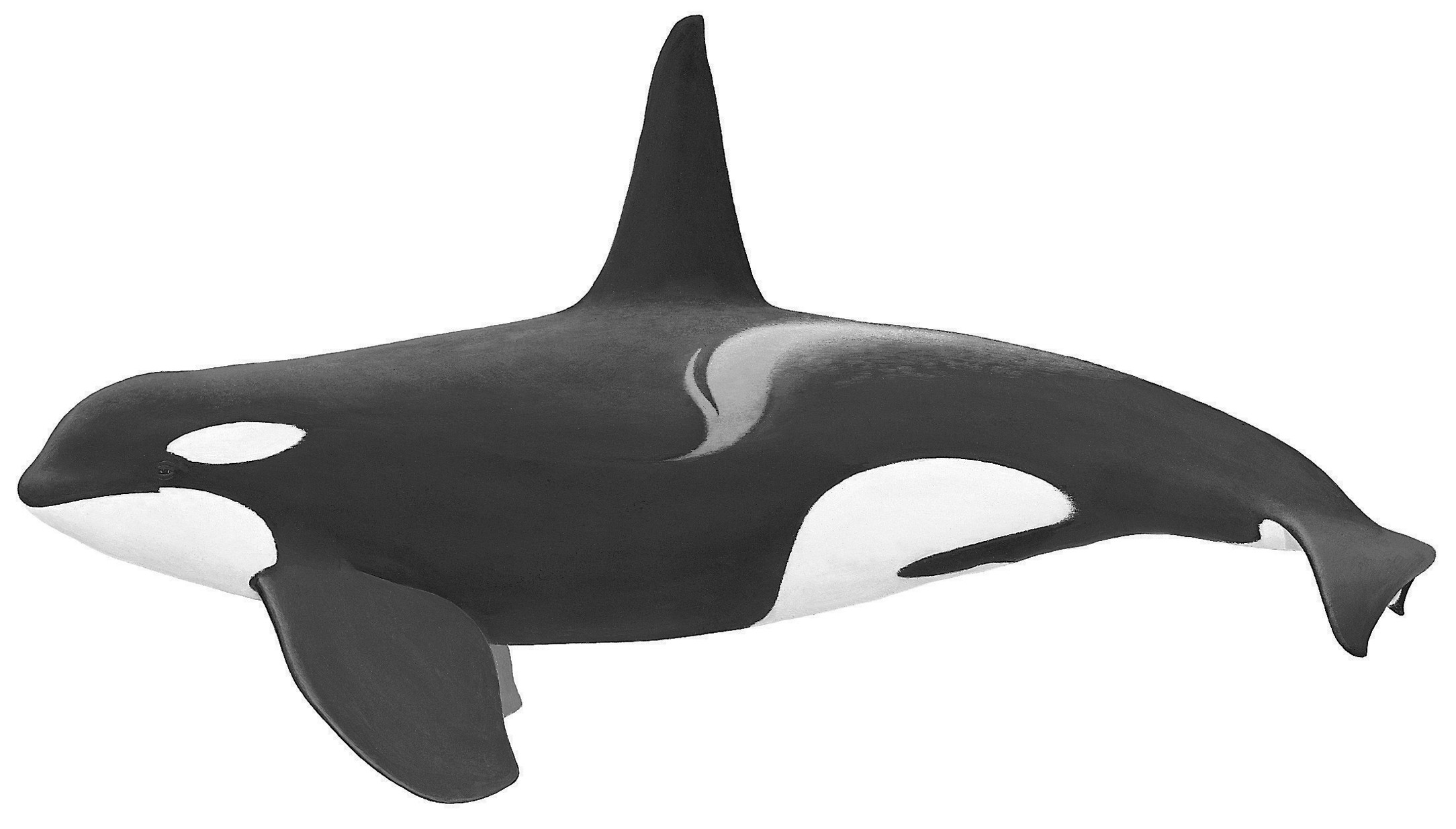KILLER WHALE
Orcinus orca (Linnaeus 1758)
Order Cetacea : Family Delphinidae
DESCRIPTION. Killer whales are the largest of the dolphin family. Adult males reach up to 9.8 m in length, although 8.2 m is average. Females typically reach 7 m in length, with the maximum about 8.5 m. Maximum weight is about 7.5 metric tons for females and 10 metric tons for males. Body form is stocky, the snout is blunt, and the flippers are large and paddle shaped. In males, the dorsal fin may be up to 1.8 m tall, but it is considerably shorter in females. Coloration is black dorsally and white ventrally from the chin to slightly behind the anus. An area of white extends up the side posterior to the dorsal fin, and a white oval is located just above and behind the eye. Each side of both jaws has 10–12 slightly curved teeth that are about 13 cm in length and interlock when the mouth is closed. The teeth are oval in cross section.

DISTRIBUTION. Killer whales are the most cosmopolitan of all cetaceans. They can be found throughout all oceans and contiguous seas, from equatorial regions to polar-pack ice zones, but they are more numerous in nearshore cold temperate to subpolar waters. They are rare in the Gulf of Mexico, although sightings have increased in recent years. They are known in Texas on the basis of one stranding on South Padre Island and one sighting in waters off Port Aransas.
SUBSPECIES. Monotypic species.
HABITS. Killer whales are one of the top-level carnivores of the world's oceans. At sea they are usually seen in pods of 5–20, although up to 150 have been seen together at one time. Large groups probably consist of several pods that have temporarily aggregated. Pods themselves appear stable for many years, with little emigration or immigration. They are highly cooperative, and the group functions as a unit when hunting, making these delphinids extremely efficient predators. Groups usually contain adults of both sexes, but sometimes females with young will form their own groups.
Food items include squid, fish, skates, rays, sharks, sea turtles, sea birds, seals, sea lions, walruses, dolphins, porpoises, and large whales such as the fin, humpback, right, minke, and gray. They are even known to attack the sperm whale and blue whale. On the Atlantic coast of South America, as well as on islands of the Indian Ocean, killer whales have been observed lunging through the surf, and coming right onto the beach, in pursuit of elephant seals and sea lions. After such an attack the whales have to wriggle and slide back into depths adequate for swimming. In captivity, killer whales eat about 45 kg of food per day, but free-ranging animals probably require much more. Although they are obviously proficient and voracious hunters, killer whale attacks on humans in the wild are extremely rare, and no fatalities in the wild are documented. Killer whales in captivity, however, have been known to attack humans, with four such attacks resulting in fatalities.
The reproductive habits of these whales are poorly known. The males may mate with more than one female, and mating may occur throughout the year, although most calves seem to appear in autumn or winter in shallow waters. Their period of gestation is about 12 months. Calves are approximately 2.4 m long at birth and reach sexual maturity when 4.9–6.1 m in length.
POPULATION STATUS. Uncommon; strandings and observations. Stranding records from the Gulf of Mexico are few and poorly documented for the killer whale, but sightings, including a few off South Padre Island, have occurred in recent years. There were 14 sightings of these unique marine mammals in the GulfCet surveys during spring and summer in a relatively small area (200 to >2,000 m [656–6,562 ft.] deep) southwest of the Mississippi Delta. It is not known whether these animals stay within the confines of the Gulf or range more widely. Estimates from the GulfCet surveys indicated that a few pods, totaling about 70 killer whales, use the offshore Gulf of Mexico as all or part of their normal range. It is possible that they are not year-round residents.
CONSERVATION STATUS. Killer whales are listed by TPWD as threatened. The USFWS recognizes the "southern resident" population of killer whales as endangered, but this resident population occurs only along the coasts of Washington, Oregon, and California. Globally, the IUCN designation is "data deficient," but the depletion of prey resources and the effects of pollutants is believed sufficient to account for a 30% global reduction over three generations. This species clearly warrants monitoring in the Gulf in the future.
From The Mammals of Texas, Seventh Edition by David J. Schmidly and Robert D. Bradley, copyright © 1994, 2004, 2016. Courtesy of the University of Texas Press.
Natural Science Research Laboratory
-
Address
Museum of Texas Tech University, 3301 4th street, Lubbock, TX 79409 -
Phone
806.742.2486 -
Email
nsrl.museum@ttu.edu

